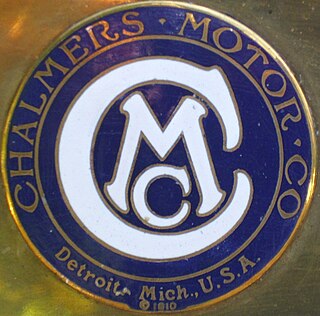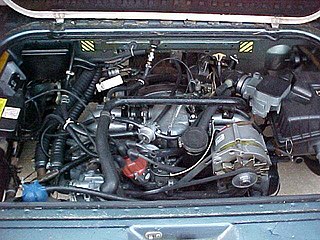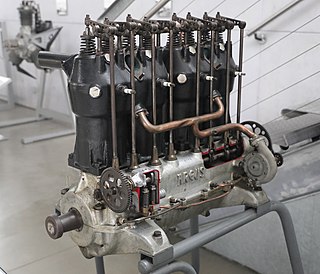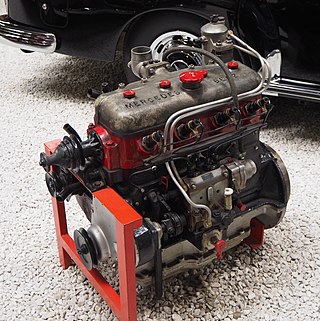Related Research Articles

A camshaft is a shaft that contains a row of pointed cams, in order to convert rotational motion to reciprocating motion. Camshafts are used in piston engines, mechanically controlled ignition systems and early electric motor speed controllers.

In an internal combustion engine, the cylinder head sits above the cylinders and forms the roof of the combustion chamber. In sidevalve engines, the head is a simple sheet of metal; whereas in more modern overhead valve and overhead camshaft engines, the cylinder head is a more complicated block often containing inlet and exhaust passages, coolant passages, valves, camshafts, spark plugs and fuel injectors. Most straight engines have a single cylinder head shared by all of the cylinders and most V engines have two cylinder heads.

The Chalmers Motor Company was an American automobile manufacturer headquartered in Detroit, Michigan. Founded in 1908 by Hugh Chalmers, the company was known for producing high-end vehicles. Chalmers automobiles gained recognition for their toughness, durability, and engineering receiving particular praise for their performance in touring events. The company reached its peak in 1911, becoming the eighth-largest auto producer in the United States. Despite initial success, the company faced challenges with increasing competition in the auto industry, and sales began to decline in the following years. In 1923, Chalmers Motor Company merged with Maxwell Motor, ultimately forming the basis for the Chrysler Corporation.

The Ford 335 engine family was a group of engines built by the Ford Motor Company between 1969 and 1982. The "335" designation reflected Ford management's decision to produce an engine of that size with room for expansion during its development. This engine family began production in late 1969 with a 351 cu in (5.8 L) engine, commonly called the 351C. It later expanded to include a 400 cu in (6.6 L) engine which used a taller version of the engine block, commonly referred to as a tall deck engine block, a 351 cu in (5.8 L) tall deck variant, called the 351M, and a 302 cu in (4.9 L) engine which was exclusive to Australia.

An overhead camshaft (OHC) engine is a piston engine in which the camshaft is located in the cylinder head above the combustion chamber. This contrasts with earlier overhead valve engines (OHV), where the camshaft is located below the combustion chamber in the engine block.

An overhead valve (OHV) engine, sometimes called a pushrod engine, is a piston engine whose valves are located in the cylinder head above the combustion chamber. This contrasts with flathead engines, where the valves were located below the combustion chamber in the engine block.

In automotive engineering a multi-valve or multivalve engine is one where each cylinder has more than two valves. A multi-valve engine has better breathing and may be able to operate at higher revolutions per minute (RPM) than a two-valve engine, delivering more power.

A flathead engine, also known as a sidevalve engine or valve-in-block engine, is an internal combustion engine with its poppet valves contained within the engine block, instead of in the cylinder head, as in an overhead valve engine.

The BMC C-Series is a straight-6 automobile engine produced from 1954 to 1971. Unlike the Austin-designed A-Series and B-Series engines, it came from the Morris Engines drawing office in Coventry and therefore differed significantly in its layout and design from the two other designs which were closely related. This was due to the C-Series being in essence an enlarged overhead valve development of the earlier 2.2 L Straight-6 overhead camshaft engine used in the post-war Morris Six MS and Wolseley 6/80 from 1948 until 1954, which itself also formed the basis of a related 1.5 L 4-cylinder engine for the Morris Oxford MO in side-valve form and the Wolseley 4/50 in overhead camshaft form. Displacement was 2.6 to 2.9 L with an undersquare stroke of 88.9 mm (3.50 in), bored out to increase capacity.

A tappet is a valve train component which converts rotating motion into linear motion in activating a valve. It is most commonly found in internal combustion engines, which converts the rotating motion of the camshaft into linear motion of intake and exhaust valves, either directly or indirectly.

A valvetrain or valve train is a mechanical system that controls the operation of the intake and exhaust valves in an internal combustion engine. The intake valves control the flow of air/fuel mixture into the combustion chamber, while the exhaust valves control the flow of spent exhaust gasses out of the combustion chamber once combustion is completed.

The Volkswagen wasserboxer is a four cylinder horizontally opposed pushrod overhead-valve (OHV) petrol engine developed by Volkswagen. The engine is water-cooled, and takes its name from the German: "wasserboxer" ("Water-boxer"); with "boxer" being another term for horizontally opposed engines. It was available in two displacements – either a 1.9-litre or a 2.1-litre; the 2.1-litre being a longer stroke version of the 1.9-litre, both variants sharing the same cylinder bore. This engine was unique to the Volkswagen Type 2 (T3), having never been used in any other vehicle. Volkswagen contracted Oettinger to develop a six-cylinder version of this engine. Volkswagen decided not to use it, but Oettinger sold a Volkswagen Type 2 (T3) equipped with this engine.

The intake/inlet over exhaust, or "IOE" engine, known in the US as F-head, is a four-stroke internal combustion engine whose valvetrain comprises OHV inlet valves within the cylinder head and exhaust side-valves within the engine block.

A V8 engine is an eight-cylinder piston engine in which two banks of four cylinders share a common crankshaft and are arranged in a V configuration.

The Argus As I was a four-cylinder, water-cooled, aircraft engine produced in Germany by Argus Motoren from 1911 until about 1913.

The MWM AKD 112 Z is an air-cooled two-cylinder inline diesel engine produced by MWM from 1955 – 1960. One, three and four cylinder variants of the same engine family were also produced by MWM.

The 4 VD 14,5/12-1 SRW is an inline four-cylinder diesel engine produced by the VEB IFA Motorenwerke Nordhausen from 1967 to 1990. The engine was one of the standard modular engines for agricultural and industrial use in the Comecon-countries. Approximately one million units were made.

The Mercedes-Benz OM 138 is a diesel engine manufactured by Daimler-Benz. In total, 5,719 units were produced between 1935 and 1940. It was the first diesel engine especially developed and made for a passenger car. The first vehicle powered by the OM 138 was the Mercedes-Benz W 138. The light Mercedes-Benz trucks L 1100 and L 1500 as well as the bus O 1500 were also offered with the OM 138 as an alternative to the standard Otto engine.
References
- 1 2 3 4 "The Great Pathfinder – "King of the Twelves"". Old Motor company. Retrieved 28 January 2020.
- 1 2 3 "AACA history". AACA. 10 November 2018. Retrieved 28 January 2020.
- ↑ "Motor Record, Volume 3, Number 1". Motor Record. January 1918. p. 176.
- ↑ "Bulb Horn Magazine, Volume 37, Issue 6". Bulb Horn Magazine. 1976. pp. 30–34.
- ↑ "Motor Record, Volume 11, Number 5". Motor Record. April 1922. p. 6.